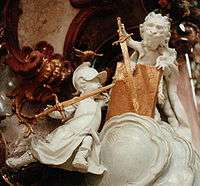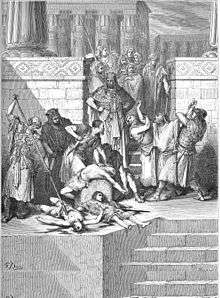Zedekiah
Zedekiah[lower-alpha 1] (/ˌzɛdɪˈkaɪə/) also known as Tzidkiyahu originally called Mattanyahu or Mattaniah, was the twentieth and last king of Judah before the destruction of the kingdom by King Nebuchadnezzar II of Babylon. Zedekiah had been installed as king of Judah by Nebuchadnezzar II, king of Babylon, after a siege of Jerusalem in 597 BC, to succeed his nephew, Jehoiachin, who was overthrown as king after a reign of only three months and ten days.
| Zedekiah | |
|---|---|
 Zedekiah from Guillaume Rouillé's Promptuarii Iconum Insigniorum, 1553 | |
| King of Judah | |
| Reign | 597–586 BC |
| Predecessor | Jehoiachin, his nephew |
| Successor | Monarchy abolished |
| Born | 617 BC, Jerusalem, Kingdom of Judah |
| Died | 586 BC Babylon, Neo-Babylonian Empire |
| House | House of David |
William F. Albright dates the start of Zedekiah's reign to 598 BC, while E. R. Thiele gives the start in 597 BC.[1] On that reckoning, Zedekiah was born in c. 617 BC or 618 BC, being twenty-one on becoming king. Zedekiah's reign ended with the siege and fall of Jerusalem to Nebuchadnezzar II, which has been dated to 587 or 586 BC.[2]
The prophet Jeremiah was his counselor, yet he did not heed the prophet and his epitaph is "he did evil in the sight of the Lord" (2 Kings 24:19–20; Jeremiah 52:2–3).
Background
When Babylon rose against Assyria it caused upheavals that led to the destruction of Judah. Egypt, concerned about the new threat, moved northward to support Assyria. It set on the march in 608, moving via Judah. King Josiah attempted to block the Egyptian forces, and fell mortally wounded in battle at Megiddo. Josiah's younger son Jehoahaz was chosen to succeed his father to the throne. Three months later the Egyptian pharaoh Necho, returning from the north, deposed Jehoahaz in favor of his older brother, Jehoiakim. Jehoahaz was taken back to Egypt as a captive.[3]
After the Egyptians were defeated by the Babylonians at the Battle of Carchemish in 605 BC, Nebuchadnezzar II then besieged Jerusalem. Jehoiakim changed allegiances to avoid the destruction of Jerusalem. He paid tribute from the treasury, some temple artifacts, and some of the royal family and nobility as hostages.[4] The subsequent failure of the Babylonian invasion into Egypt undermined Babylonian control of the area, and after three years, Jehoiakim switched allegiance back to the Egyptians and ceased paying the tribute to Babylon.[5] In 599 BC, Nebuchadnezzar II invaded Judah and again laid siege to Jerusalem. In 598 BC, Jehoiakim died during the siege and was succeeded by his son Jeconiah (also known as Jehoiachin). Jerusalem fell within three months. Jeconiah was deposed by Nebuchadnezzar, who installed Zedekiah, Jeconiah's uncle, in his place.[6][7]
Life and reign

According to the Hebrew Bible, Zedekiah was made king of Judah by Nebuchadnezzar II in 597 BC at the age of twenty-one. This is in agreement with a Babylonian chronicle, which states, "The seventh year: In the month Kislev the king of Akkad mustered his army and marched to Hattu. He encamped against the city of Judah and on the second day of the month Adar he captured the city (and) seized (its) king. A king of his own choice he appointed in the city (and) taking the vast tribute he brought it into Babylon."[8]
The kingdom was at that time tributary to Nebuchadnezzar II. Despite the strong remonstrances of Jeremiah, Baruch ben Neriah and his other family and advisors, as well as the example of Jehoiakim, he revolted against Babylon, and entered into an alliance with Pharaoh Hophra of Egypt. Nebuchadnezzar responded by invading Judah (2 Kings 25:1). Nebuchadnezzar began a siege of Jerusalem in December 589 BC. During this siege, which lasted about thirty months,[9] "every worst woe befell the city, which drank the cup of God's fury to the dregs" (2 Kings 25:3; Lamentations 4:4, 5, 9).
At the end of Zedekiah's eleven-year reign, Nebuchadnezzar succeeded in capturing Jerusalem. Zedekiah and his followers attempted to escape, making their way out of the city, but were captured on the plains of Jericho, and were taken to Riblah.
There, after seeing his sons put to death, his own eyes were put out, and, being loaded with chains, he was carried captive to Babylon (2 Kings 25:1–7; 2 Chronicles 36:12; Jeremiah 32:4–5; 34:2–3; 39:1–7; 52:4–11; Ezekiel 12:13), where he remained a prisoner until he died.
After the fall of Jerusalem, Nebuzaradan was sent to destroy it. The city was plundered and razed to the ground. Solomon's Temple was destroyed. Only a small number of vinedressers and husbandmen were permitted to remain in the land (Jeremiah 52:16).
Aftermath
Gedaliah, with a Chaldean guard stationed at Mizpah, was made governor to rule over the remnant of Judah, the Yehud Province (2 Kings 25:22-24, Jeremiah 40:6–8). On hearing this news, all the Jews that were in Moab, Ammon, Edom, and in other countries returned to Judah (Jeremiah 40:11–12). However, before long Gedaliah was assassinated, and the population that was left in the land and those that had returned fled to Egypt for safety (2 Kings 25:26, Jeremiah 43:5–7) In Egypt, they settled in Migdol, Tahpanhes, Noph, and Pathros. (Jeremiah 44:1).
Chronological notes

The Babylonian Chronicles give 2 Adar (16 March), 597 BC, as the date that Nebuchadnezzar captured Jerusalem, thus putting an end to the reign of Jehoaichin.[10] Zedekiah's installation as king by Nebuchadnezzar can therefore be firmly dated to the early spring of 597 BC. Historically there has been considerable controversy over the date when Jerusalem was captured the second time and Zedekiah's reign came to an end. There is no dispute about the month: it was the summer month of Tammuz (Jeremiah 52:6). The problem has been to determine the year. It was noted above that Albright preferred 587 BC and Thiele advocated 586 BC, and this division among scholars has persisted until the present time. If Zedekiah's years are by accession counting, whereby the year he came to the throne was considered his "zero" year and his first full year in office, 597/596, was counted as year one, Zedekiah's eleventh year, the year the city fell, would be 587/586. Since Judean regnal years were measured from Tishri in the fall, this would place the end of his reign and the capture of the city in the summer of 586 BC. Accession counting was the rule for most, but not all, of the kings of Judah, whereas "non-accession" counting was the rule for most, but not all, of the kings of Israel.[1][11]
The publication of the Babylonian Chronicles in 1956, however, gave evidence that the years of Zedekiah were measured in a non-accession sense. This reckoning makes year 598/597 BC, the year Zedekiah was installed by Nebuchadnezzar according to Judah's Tishri-based calendar, to be year "one," so that the fall of Jerusalem in his eleventh year would have been in year 588/587 BC, i.e. in the summer of 587 BC. The Babylonian Chronicles allow the fairly precise dating of the capture of Jehoiachin and the start of Zedekiah's reign, and they also give the accession year of Nebuchadnezzar's successor Amel-Marduk (Evil Merodach) as 562/561 BC, which was the 37th year of Jehoiachin's captivity according to 2 Kings 25:27. These Babylonian records related to Jehoiachin's reign are consistent with the fall of the city in 587 but not in 586, thus vindicating Albright's date. Nevertheless, scholars who assume that Zedekiah's reign should be calculated by accession reckoning will continue to adhere to the 586 date, and so the infobox contains this as an alternative.
Book of Mormon
According to the Book of Mormon, a religious text in the Latter Day Saint Movement, Zedekiah had a son name Mulek, who escaped death and traveled across the ocean to the Americas, where he founded a nation, the Mulekites, which later merged with another Israelite splinter group, the Nephites, to form one nation who retained the name Nephites.[12][13]
Genealogical note
Zedekiah was the third son of Josiah, and his mother was Hamutal the daughter of Jeremiah of Libnah, thus he was the brother of Jehoahaz (2 Kings 23:31, 24:17-18, 23:31, 24:17-18).
His original name was Mattanyahu (Hebrew: מַתַּנְיָהוּ, Mattanyāhû, "Gift of God"; Greek: Μαθθανιας; Latin: Matthanias; traditional English: Mattaniah), but when Nebuchadnezzar II placed him on the throne as the successor to Jehoiachin, he changed his name to Zedekiah (2 Kings 24:17).
Zedekiah | ||
| Regnal titles | ||
|---|---|---|
| Preceded by Jehoiachin |
King of Judah 597–587 or 586 BC |
Judah conquered by Nebuchadnezzar II of Babylon |
| Leader of the House of David | Succeeded by Shealtiel | |
See also
| Wikimedia Commons has media related to Zedekiah. |
- Jeconiah (for a more complete discussion on chronology)
- Zedekiah's Cave
Notes
References
- Edwin Thiele, The Mysterious Numbers of the Hebrew Kings, (1st ed.; New York: Macmillan, 1951; 2d ed.; Grand Rapids: Eerdmans, 1965; 3rd ed.; Grand Rapids: Zondervan/Kregel, 1983). ISBN 0-8254-3825-X, 9780825438257, 217.
- Robb Andrew Young (3 May 2012). Hezekiah in History and Tradition. BRILL. p. 18. ISBN 90-04-21608-1.
- Bakon, Shimon. "Zedekiah: Last King of Judah", Jewish Bible Quarterly, Vol. 36, No. 2, 2008.
- C. Hassell Bullock. An Introduction to the Old Testament Prophetic Books. p. 340.
- Rollinson, Shirley J. (June 28, 2017). "The Divided Monarchy c. 931–586 BC". Retrieved March 14, 2018.
- 2 Chronicles 36:9-10
- The Oxford History of the Biblical World, ed. by Michael D Coogan. Published by Oxford University Press, 1999. pg 350
- Readings from the Ancient Near East: Primary Sources for Old Testament Study. Baker Academic. p. 159. ISBN 978-0801022920.
- Knight, Doug and Amy-Jill Levine (2011). The Meaning of the Bible. New York City: HarperOne. p. 31. ISBN 9780062067739.
- D. J. Wiseman, Chronicles of Chaldean Kings in the British Museum (London: Trustees of the British Museum, 1956) 73.
- Leslie McFall, "A Translation Guide to the Chronological Data in Kings and Chronicles," Bibliotheca Sacra 148 (1991) 45.
- Helaman 6:10
- Helaman 8:21